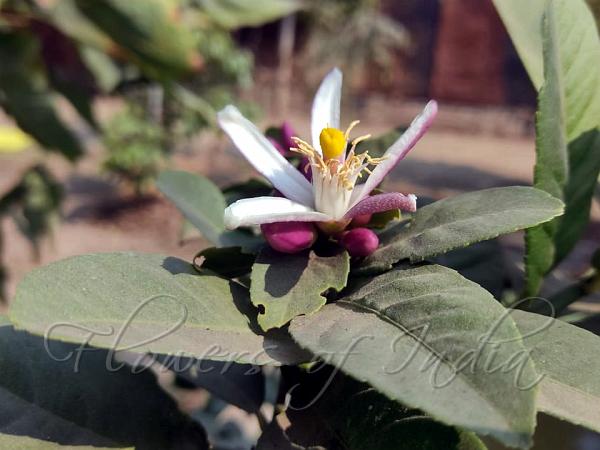|
| Citron |
|

|

|
|
|
|
Photo: |
Botanical name: Citrus medica Family: Rutaceae (Lemon family)
Synonyms: Citrus bicolor, Citrus cedra, Citrus limetta, Citrus limetta
Synonyms: Citrus bicolor, Citrus cedra, Citrus limetta, Citrus limetta
Citron is a large lemon-like fruit borne by a
slow-growing shrub or small tree reaching 8-15 ft high with stiff
branches and stiff twigs and short or long spines in the leaf axils.
Citron is probably native to North-East India. The leaflets are
evergreen, lemon-scented, ovate-lanceolate or ovate elliptic, 2.5-7 in
long, leathery, with short, wingless or nearly wingless petioles. The
flower buds are large and white or sometimes purplish. The fragrant
flowers about 4 cm wide, in short clusters, have 4 to 5 petals,
sometimes pinkish or purplish on the outside, with 30 to 60 stamens.
The fruit is fragrant, mostly oblong, obovoid or oval, occasionally
pyriform, but highly variable; various shapes and smooth or rough
fruits sometimes occurring on the same branch. The citron is unlike the
more common citrus fruit like the lemon or orange. While the most
popular citrus species are peeled in order to consume its pulpy and
juicy segments, the citron's pulp is very dry containing only little
insipid juice. Citron is native to the Himalaya to Myanmar.
Flowering: February-May.
Medicinal uses: Juice- It is indicated in
mostly digestion related problems. It also acts in stimulating liver
for proper secretion of bile juices. It is also given in conditions
like nausea. Leaves are externally used in case of pains and
inflammation on the external body part. It is also used on skin
disorders and also relieves from itching. Paste made out of seeds is
also very helpful in scorpion bite.
Juice- It is indicated in
mostly digestion related problems. It also acts in stimulating liver
for proper secretion of bile juices. It is also given in conditions
like nausea. Leaves are externally used in case of pains and
inflammation on the external body part. It is also used on skin
disorders and also relieves from itching. Paste made out of seeds is
also very helpful in scorpion bite.
Medicinal uses:
 Juice- It is indicated in
mostly digestion related problems. It also acts in stimulating liver
for proper secretion of bile juices. It is also given in conditions
like nausea. Leaves are externally used in case of pains and
inflammation on the external body part. It is also used on skin
disorders and also relieves from itching. Paste made out of seeds is
also very helpful in scorpion bite.
Juice- It is indicated in
mostly digestion related problems. It also acts in stimulating liver
for proper secretion of bile juices. It is also given in conditions
like nausea. Leaves are externally used in case of pains and
inflammation on the external body part. It is also used on skin
disorders and also relieves from itching. Paste made out of seeds is
also very helpful in scorpion bite. | Identification credit: Eby Abraham | Photographed in Manipur, Maharashtra & Mizoram. |
• Is this flower misidentified? If yes,